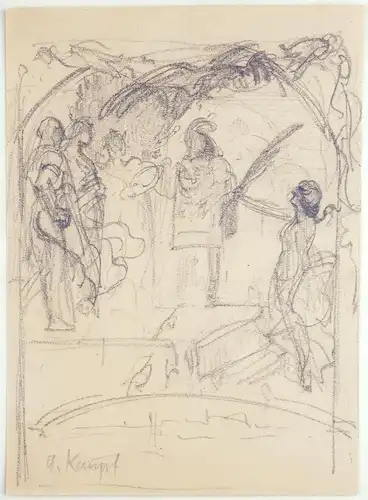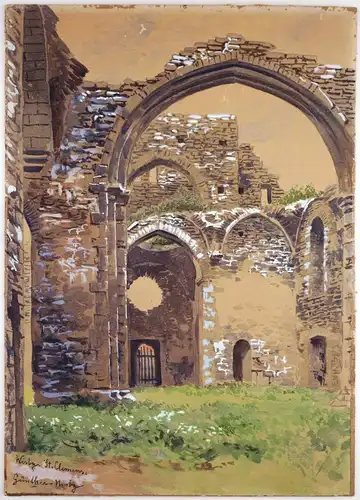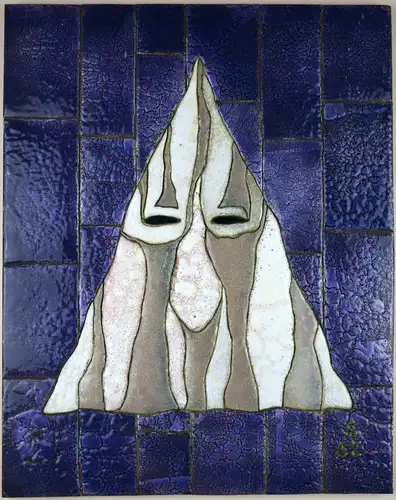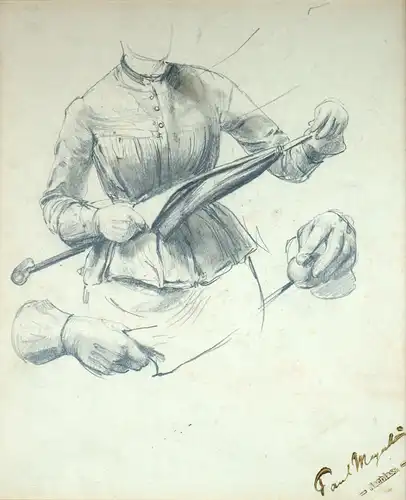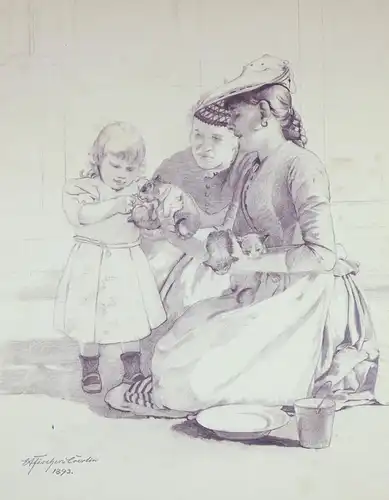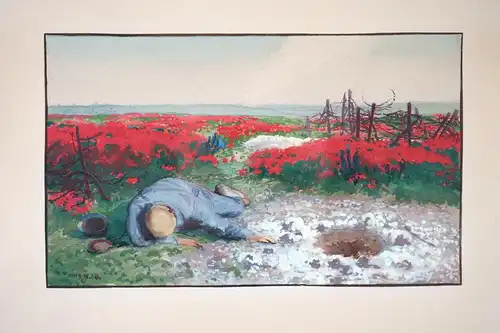Beschreibung
Otto Günther-Naumburg (1856-1941), Die Kirchenruine St. Clemens im schwedischen Visby. Aquarell und Tusche, weiß gehöht, auf sandfarbenem Papier, auf Karton montiert, 33 x 24 cm, unten links mit „Günther-Naumburg“ signiert und mit „Wisby. St. Clemens“ bezeichnet.
- an den Randbereichen Reste einer alten Montage, sonst in gutem Zustand
- Reale Romantik -
zum Kunstwerk
Visby auf Gotland hatte im Mittelalter auf engstem Raum insgesamt 14 Kirchen, von denen heutzutage nur noch der Dom erhalten geblieben ist. Die meisten Gotteshäuser wurden im Zuge der Reformation und des dänischen Thronfolgestreits zwischen Christian II. und Frederik I. im 16. Jahrhundert zerstört, so dass Visby lange einer sakralen Ruinenlandschaft glich.
Mit Otto Günther-Naumburg stehen wir im ehemaligen Chor von St. Clemens und blicken durch den erhaltenen Triumphbogen in das ruinöse Langhaus, mit seiner Vorhalle und den Überresten des Fassadenaufbaus. Auch wenn das Gewölbe fehlt, hat der monumental wirkende Bogen seine statische Kraft bewahrte und gibt nun den Blick in den Himmel frei, wodurch der Sakralbau trotz seines ruinösen Zustandes keineswegs seinen sakralen Charakter verloren hat. Mit der Kunst Caspar David Friedrichs sind Kirchenruinen zu einem besonderen Sehnsuchtsort geworden, der eine intensive sakrale Aura verbreitet. Diese romantische Dimension findet sich auch in der Pforte, die zwar verschlossen ist und dennoch einen Durchblick auf den jenseitigen Sonnenuntergang freigibt. Eine Sphäre, die uns diesseitig allerdings noch nicht zugänglich ist.
Die Brauntonalität des verwendeten Papiers bestimmt die Erscheinung des Bildes. Von diesem Grundton ausgehend, kreiert Günther-Naumburg mit lasierend aufgetragenem Schwarz die Steine des Gemäuers, die er gekonnt durch Weißhöhungen akzentuiert. Mit dem Braun tritt das virtuos gesetzte Grün der Vegetation in einen harmonischen Kontrast, so dass der Blick immer wieder von Neuem die Ruine erkundet. Neben dem romantischen Gehalt des Bildes ist das Aquarell zugleich eine historische Momentaufnahme wie S. Clemens in Visby um 1900 ausgesehen hat.
zum Künstler
Ab 1861 in Berlin ansässig, studierte Otto Günther-Naumburg von 1873-1877 an der Berliner Akademie der Künste, zunächst bei Albert Hertel und dann unter dessen Nachfolger Christian Wilberg. Von 1877 an beschickte er die Akademie-Ausstellung, ab 1891 war er im Münchner Glaspalast vertreten und ab 1893 wurden Werke von ihm auf der Großen Berliner Kunstausstellung gezeigt. Studienreisen führten ihn nach Süddeutschland, Tirol, Schweiz, Italien und nach Schweden.
Eine besondere Meisterschaft entwickelte Otto Günther-Naumburg in der Aquarellmalerei, die er ab 1892 als Professor an der Technischen Hochschule Berlin lehrte. Er fertigte aber auch großformatige Gemälde an und kam öffentlichen Aufträgen nach. So stattete er unter anderem den Rathaussaal von Dillingen aus, schuf für das Preußische Abgeordnetenhaus die Städtebilder ‚Posen‘ und ‚Breslau‘ und gestaltetet für das Potsdamer Rathaus eine Ansicht der Stadt. Zudem war Otto Günther-Naumburg als Illustrator für die Leipziger illustrierte Zeitung, Daheim und die Gartenlaube tätig, wodurch er weithin bekannt und geschätzt wurde.
Auswahlbibliographie
Thieme-Becker. Allgemeines Lexikon der Bildenden Künstler von der Antike bis zur Gegenwart, Band 15, Leipzig 1922, S. 210.
Saur. Allgemeines Künstler-Lexikon, Band 64, München - Leipzig 2009, S. 415.
ENGLISH VERSION
Otto Günther-Naumburg (1856-1941), The Ruins of St. Clement's Church in Visby, Sweden. Watercolor and ink, heightened with white, on sand-colored paper, mounted on cardboard, 33 x 24 cm, signed at lower left "Günther-Naumburg" and inscribed "Wisby. St. Clemens".
- At the margins remains of an old mounting, otherwise good condition.
- Real romanticism -
About the artwork
In the Middle Ages, Visby on Gotland had a total of 14 churches in a very small area, of which only the cathedral remains today. Most of the churches were destroyed in the course of the Reformation and the Danish war of succession between Christian II and Frederik I in the 16th century, so that for a long time Visby resembled a landscape of sacral ruins.
With Otto Günther-Naumburg we stand in the former choir of St. Clement's and look through the preserved triumphal arch into the ruined nave with its narthex and the remains of the façade. Although the vault is missing, the monumental arch has retained its static strength and now offers a view of the sky, so that the sacred building has in no way lost its sacred character despite its ruinous state. In the art of Caspar David Friedrich, church ruins have become a special place of longing, exuding an intense sacral aura. This romantic dimension is also found in the gate, which, although closed, offers a view of the sunset behind it. A sphere, however, that is not yet accessible to us from this side.
The brown tonality of the paper determines the appearance of the image. Starting from this basic tone, Günther-Naumburg creates the stones of the masonry with glazed black, which he skillfully accentuates with white highlights. The virtuoso green of the vegetation contrasts harmoniously with the brown, so that the viewer's gaze is constantly exploring the ruin. In addition to the romantic content of the picture, the watercolor is also a historical snapshot of how St. Clemens in Visby looked around 1900.
About the artist
Otto Günther-Naumburg, who had lived in Berlin since 1861, studied at the Berlin Academy of Arts from 1873 to 1877, first with Albert Hertel and then with his successor Christian Wilberg. From 1877 he exhibited at the Academy Exhibition, from 1891 at the Munich Glass Palace, and from 1893 at the Great Berlin Art Exhibition. Study trips took him to Southern Germany, Tyrol, Switzerland, Italy and Sweden.
Otto Günther-Naumburg developed a special mastery in watercolor painting, which he taught as a professor at the Technical University in Berlin from 1892. He also produced large-format paintings and fulfilled public commissions. He decorated the town hall of Dillingen, created the cityscapes "Posen" and "Breslau" for the Prussian House of Representatives, and designed a view of the city for the Potsdam Town Hall. In addition, Otto Günther-Naumburg worked as an illustrator for the Leipziger Illustrierte Zeitung, Daheim and the Gartenlaube, which made him widely known and appreciated.
Selected Bibliography
Thieme-Becker. Allgemeines Lexikon der Bildenden Künstler von der Antike bis zur Gegenwart, Band 15, Leipzig 1922, S. 210.
Saur. Allgemeines Künstler-Lexikon, Band 64, München - Leipzig 2009, S. 415.

